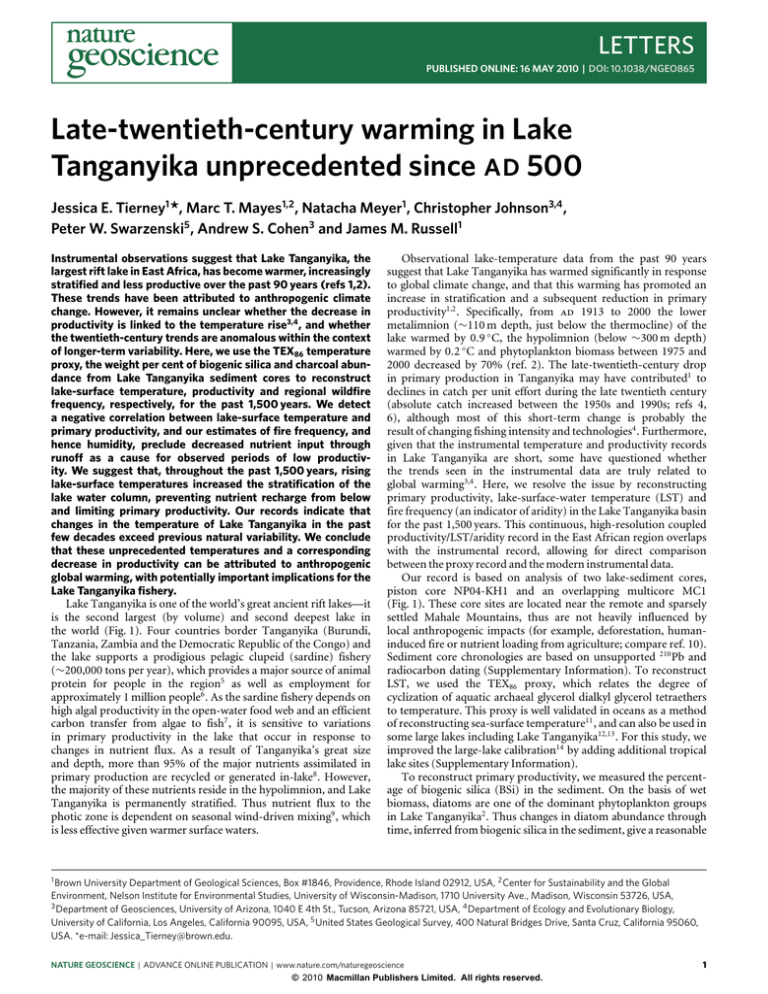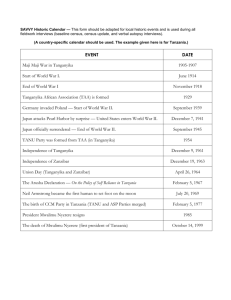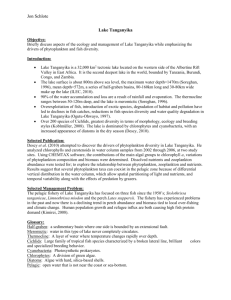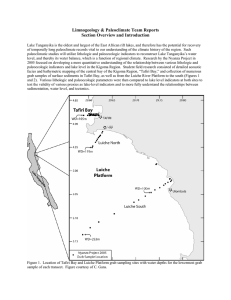
LETTERS
PUBLISHED ONLINE: 16 MAY 2010 | DOI: 10.1038/NGEO865
Late-twentieth-century warming in Lake
Tanganyika unprecedented since AD 500
Jessica E. Tierney1 *, Marc T. Mayes1,2 , Natacha Meyer1 , Christopher Johnson3,4 ,
Peter W. Swarzenski5 , Andrew S. Cohen3 and James M. Russell1
Instrumental observations suggest that Lake Tanganyika, the
largest rift lake in East Africa, has become warmer, increasingly
stratified and less productive over the past 90 years (refs 1,2).
These trends have been attributed to anthropogenic climate
change. However, it remains unclear whether the decrease in
productivity is linked to the temperature rise3,4 , and whether
the twentieth-century trends are anomalous within the context
of longer-term variability. Here, we use the TEX86 temperature
proxy, the weight per cent of biogenic silica and charcoal abundance from Lake Tanganyika sediment cores to reconstruct
lake-surface temperature, productivity and regional wildfire
frequency, respectively, for the past 1,500 years. We detect
a negative correlation between lake-surface temperature and
primary productivity, and our estimates of fire frequency, and
hence humidity, preclude decreased nutrient input through
runoff as a cause for observed periods of low productivity. We suggest that, throughout the past 1,500 years, rising
lake-surface temperatures increased the stratification of the
lake water column, preventing nutrient recharge from below
and limiting primary productivity. Our records indicate that
changes in the temperature of Lake Tanganyika in the past
few decades exceed previous natural variability. We conclude
that these unprecedented temperatures and a corresponding
decrease in productivity can be attributed to anthropogenic
global warming, with potentially important implications for the
Lake Tanganyika fishery.
Lake Tanganyika is one of the world’s great ancient rift lakes—it
is the second largest (by volume) and second deepest lake in
the world (Fig. 1). Four countries border Tanganyika (Burundi,
Tanzania, Zambia and the Democratic Republic of the Congo) and
the lake supports a prodigious pelagic clupeid (sardine) fishery
(∼200,000 tons per year), which provides a major source of animal
protein for people in the region5 as well as employment for
approximately 1 million people6 . As the sardine fishery depends on
high algal productivity in the open-water food web and an efficient
carbon transfer from algae to fish7 , it is sensitive to variations
in primary productivity in the lake that occur in response to
changes in nutrient flux. As a result of Tanganyika’s great size
and depth, more than 95% of the major nutrients assimilated in
primary production are recycled or generated in-lake8 . However,
the majority of these nutrients reside in the hypolimnion, and Lake
Tanganyika is permanently stratified. Thus nutrient flux to the
photic zone is dependent on seasonal wind-driven mixing9 , which
is less effective given warmer surface waters.
Observational lake-temperature data from the past 90 years
suggest that Lake Tanganyika has warmed significantly in response
to global climate change, and that this warming has promoted an
increase in stratification and a subsequent reduction in primary
productivity1,2 . Specifically, from ad 1913 to 2000 the lower
metalimnion (∼110 m depth, just below the thermocline) of the
lake warmed by 0.9 ◦ C, the hypolimnion (below ∼300 m depth)
warmed by 0.2 ◦ C and phytoplankton biomass between 1975 and
2000 decreased by 70% (ref. 2). The late-twentieth-century drop
in primary production in Tanganyika may have contributed1 to
declines in catch per unit effort during the late twentieth century
(absolute catch increased between the 1950s and 1990s; refs 4,
6), although most of this short-term change is probably the
result of changing fishing intensity and technologies4 . Furthermore,
given that the instrumental temperature and productivity records
in Lake Tanganyika are short, some have questioned whether
the trends seen in the instrumental data are truly related to
global warming3,4 . Here, we resolve the issue by reconstructing
primary productivity, lake-surface-water temperature (LST) and
fire frequency (an indicator of aridity) in the Lake Tanganyika basin
for the past 1,500 years. This continuous, high-resolution coupled
productivity/LST/aridity record in the East African region overlaps
with the instrumental record, allowing for direct comparison
between the proxy record and the modern instrumental data.
Our record is based on analysis of two lake-sediment cores,
piston core NP04-KH1 and an overlapping multicore MC1
(Fig. 1). These core sites are located near the remote and sparsely
settled Mahale Mountains, thus are not heavily influenced by
local anthropogenic impacts (for example, deforestation, humaninduced fire or nutrient loading from agriculture; compare ref. 10).
Sediment core chronologies are based on unsupported 210 Pb and
radiocarbon dating (Supplementary Information). To reconstruct
LST, we used the TEX86 proxy, which relates the degree of
cyclization of aquatic archaeal glycerol dialkyl glycerol tetraethers
to temperature. This proxy is well validated in oceans as a method
of reconstructing sea-surface temperature11 , and can also be used in
some large lakes including Lake Tanganyika12,13 . For this study, we
improved the large-lake calibration14 by adding additional tropical
lake sites (Supplementary Information).
To reconstruct primary productivity, we measured the percentage of biogenic silica (BSi) in the sediment. On the basis of wet
biomass, diatoms are one of the dominant phytoplankton groups
in Lake Tanganyika2 . Thus changes in diatom abundance through
time, inferred from biogenic silica in the sediment, give a reasonable
1 Brown
University Department of Geological Sciences, Box #1846, Providence, Rhode Island 02912, USA, 2 Center for Sustainability and the Global
Environment, Nelson Institute for Environmental Studies, University of Wisconsin-Madison, 1710 University Ave., Madison, Wisconsin 53726, USA,
3 Department of Geosciences, University of Arizona, 1040 E 4th St., Tucson, Arizona 85721, USA, 4 Department of Ecology and Evolutionary Biology,
University of California, Los Angeles, California 90095, USA, 5 United States Geological Survey, 400 Natural Bridges Drive, Santa Cruz, California 95060,
USA. *e-mail: Jessica_Tierney@brown.edu.
NATURE GEOSCIENCE | ADVANCE ONLINE PUBLICATION | www.nature.com/naturegeoscience
© 2010 Macmillan Publishers Limited. All rights reserved.
1
NATURE GEOSCIENCE DOI: 10.1038/NGEO865
LETTERS
26.5
24° N
3° S
g
L. Tan
5° S
6° S
D.R. Congo
8° S
24° S
9° S
Zambia
30’
0°
12° E
24° E
36° E
29° E
30’
48° E
30° E
30’
31° E
Lake Tanganyika LST (°C)
7° S
12° S
Wet
25.0
Dry
Hypolimnion
24.5
24.0
23.5
26
a
East African
rift lakes
Tanzania
anyik
0°
T (°C)
4° S
12° N
Kalya LST
26.0 TEX
86
25.5 110 m
Burundi
30’
a
23.0
22.5
1860
25
1900
1940
1980
Year AD
24
23
22
60° E
b
2
2
0
¬1
4
Normalized charcoal
estimate of primary productivity in the lake. To reconstruct fire
frequency and aridity in the Tanganyika basin, we measured the
abundance of charcoal particles in the sediment. Though fire
frequency can be controlled by the amount of biomass available
for burning, charcoal has been previously shown to be a reliable
indicator of Tanganyika basin aridity in areas of low population
density such as our coring site10 . Furthermore, our charcoal results
from MC1 show a systematic decrease (wetter conditions) from the
late 1800s to the present, similar to the instrumental trend for the
greater East African region15 . BSi and charcoal data are shown here
in units of normalized abundance (Supplementary Information).
Figure 2 summarizes our results. Before the twentieth century,
LST varied between 22.5 ◦ C and 24.3 ◦ C (Fig. 2a). LSTs were
relatively warm between ad 500 and 700, followed by an interval
of cool LSTs that lasted until ad 1100. Lake Tanganyika then
experienced a period of extended warmth between 1100 and 1400,
followed by a return to cooler LSTs between 1400 and 1500 and
more variable temperatures until 1900. Beginning around 1900,
LSTs trend upwards, rising about 2 ◦ C in 100 years (see Fig. 2 inset).
Our uppermost sample from core MC1 (identified using 210 Pb
dating as about ad 1996), calibrates to 25.7 ◦ C. This is within the
range of 2003 measurements of seasonal LST for the Kalya Slope
area (25.5–26.3 ◦ C; see Fig. 2 inset) and is also similar to the annual
average LST measured near Mpulungu, at the southern end of the
lake (26.1 ◦ C; ref. 16).
Our inferred surface warming is more than twice the magnitude
of the warming that has occurred below the thermocline at
110 m (Fig. 2 inset), verifying the supposition made from deepwater measurements alone1,2 that Lake Tanganyika developed an
increasingly greater temperature gradient between the epilimnion
and hypolimnion during the twentieth century. Our inference that
LSTs increased by 2 ◦ C since 1900 is higher than the instrumental
estimate of LST warming (1.3 ◦ C since ad 1913; ref. 17), but this
discrepancy may be a consequence of the limited number of LST
measurements in the historical dataset vis à vis the seasonal and
spatial variability in Tanganyika LST. Furthermore, the increase in
LST between the mid-1960s and 1990 inferred from our proxy data
(1 ◦ C) is similar to the observed 0.8 ◦ C rise in Tanganyika-basin
air temperatures during the same time interval17 , demonstrating
that Tanganyika LSTs are keeping pace with rising air temperatures.
In a warming climate, it might be expected that in a deep lake
such as Tanganyika the LST would increase more slowly than air
1
3
Normalized BSi
Figure 1 | The location of Lake Tanganyika, East Africa and the sediment
cores KH1 and MC1 analysed in this study. Cores were collected from the
Kalya Platform area, 6◦ 33.1470 S 29◦ 58.4800 E, 309 m water depth; pink
dot in inset.
¬2
c
2
1
0
¬1
500
750
1000
1250
Year AD
1500
1750
2000
Figure 2 | The Lake Tanganyika palaeorecord for the past 1,500 years.
a, TEX86 -inferred LST measured in core KH1 (red line) and MC1 (dark red
line), orange shading is 95% error bars, which include analytical error and a
leave-one-out estimate of calibration error (Supplementary Information).
b, Normalized biogenic silica abundance in core KH1 (green line) and MC1
(dark-green line). c, Normalized charcoal abundance in core KH1 (purple
line) and MC1 (dark-purple line). Plotted below the charcoal data are 14 C
dates (with 1σ errors), unsupported 210 Pb dates (blue) and a stratigraphic
tie point between MC1 and KH1 (pink). The inset shows TEX86 LST data
from multicore MC1 alongside instrumental 110 m temperatures2 (dark
orange) and hypolimnion temperatures2 (light blue) and instrumental LST
in the Kalya Slope area for the wet (stratified) season (white square) and
dry (upwelling) season (grey square) in 2003 (ref. 16).
temperature owing to the transfer of heat to the deep hypolimnion
through mixing (much like the ocean). In fact, it seems that the
increasingly severe stratification in Tanganyika slows the transfer
of heat to deeper waters and enables Tanganyika to behave like a
shallower water body, where increases in LSTs keep pace, or even
exceed, increases in air temperatures17 . Our data thus support the
argument that the estimated 0.4 W m−2 net heat absorption by
Lake Tanganyika since 1913, which is about twice the rate in the
global ocean, is largely a reflection of stronger climate forcing in the
East African region17 . The correlation, both visual and statistical,
between LST and BSi highlights the relationship between LST,
wind mixing and related changes in primary productivity (Fig. 2).
Over our entire record, LST and BSi are significantly negatively
NATURE GEOSCIENCE | ADVANCE ONLINE PUBLICATION | www.nature.com/naturegeoscience
© 2010 Macmillan Publishers Limited. All rights reserved.
NATURE GEOSCIENCE DOI: 10.1038/NGEO865
correlated (r = −0.576, p = 0.001, n = 75). Excluding the twentiethcentury data, which have a strong antiphased trend, LST and BSi
are still significantly correlated above the 99% confidence level
(r = −0.524, p = 0.003,n = 70). This demonstrates that low LSTs are
generally associated with higher diatom productivity before strong
anthropogenic forcing of global climate. In the past 150 years, BSi
values plummeted from relatively high levels during the early 1800s
to some of the lowest sustained values during the past 1,500 years.
This abrupt drop occurred in concert with the rapid rise in LST,
implying that warm LSTs had a negative impact on lake primary
productivity throughout the twentieth century through an increase
in water-column stratification.
It is also possible that, on multidecadal and longer timescales,
higher rates of precipitation may have increased nutrient recharge
and availability, and hence primary productivity18 . However, our
charcoal data (Fig. 2c) show that humid conditions (low charcoal)
were associated with low productivity from ad 1500 to 1650 and
from the mid-nineteenth century onwards, and arid conditions
(high charcoal) accompanied high productivity from 1650 to 1800.
In addition, BSi and charcoal have a very weak positive correlation
(r = 0.348, n = 149, p = 0.074). Alternatively, given the size of
Lake Tanganyika, there could be a significant lag time between
nutrient recharge and utilization by surface production. Given
estimates of nutrient residence times in Lake Tanganyika (nitrogen,
4.6 years; phosphorus, 140 years; silica, 6,800 years; ref. 8), only
phosphorus has a residence time compatible with the timescale
of productivity variations observed in our record. Calculation of
the lagged cross-correlation function between the BSi and charcoal
time series reveals that the highest (negative) correlation value (high
productivity as a consequence of wet conditions) occurs at a timelag
of 260 years (r = −0.387, n = 149, p < 0.05). This could support
the nutrient recharge hypothesis, but the correlation coefficient is
nearly equal in magnitude to the zero-lag value, and is largely driven
by movement of the arid period from 1650 to 1800 forward into the
modern (low-BSi) interval. As the relationship between LST and BSi
is more robust, we conclude that, in the recent past and on these
timescales, it is temperature and its effect on stratification, and not
rainfall, that is largely controlling primary productivity.
Our LST reconstruction is qualitatively similar to Northern
Hemisphere temperature reconstructions19 (Fig. 3a), implying that
Tanganyika LST largely followed global trends in temperature
during the past 1,500 years, much as it has in the past half-century17 .
As LST closely tracks air temperatures over the instrumental
period, we can also infer that air temperatures in this region
of East Africa varied in concert with the global average and
thus were controlled primarily by the major forcings influencing
temperatures over this timescale, both natural (solar radiation,
volcanism) and anthropogenic (greenhouse-gas emissions; refs 19,
20). The temporal resolution of our dataset precludes comparison
between Tanganyika LST and volcanic events of the past, but we
can compare our record with changes in solar irradiance (total
solar irradiance (TSI) anomaly, estimated from 10 Be in ice cores21 ;
Fig. 3b). TSI and Tanganyika LST share some similar centennialscale features, including maxima near 1350 and minima at 1450,
1250 and 1000. However, TSI variability clearly does not explain the
dramatic twentieth-century increase in LST, which, as with global
temperatures, is probably a response to greenhouse-gas forcing.
Our palaeorecords show that the LST increase in Lake
Tanganyika during the past 90 years is uncharacteristic of the
preceding natural variability and unprecedented in the past
1,500 years, suggesting that the recent anomalous trend in
Tanganyika LST is a response to anthropogenic greenhouse-gas
forcing. Furthermore, our data demonstrate that LST and primary
productivity are closely related in both the pre-anthropogenic and
anthropogenic eras, confirming that warm surface temperatures
increase the degree of stratification within Lake Tanganyika and
LETTERS
Figure 3 | A comparison between Lake Tanganyika LST and global
temperature trends and forcings. a, Lake Tanganyika LST (black, including
95% error) plotted next to composite Northern Hemisphere temperature
anomaly reconstructions19 ; colours represent the percentage agreement
between the reconstructions. b, Lake Tanganyika LST and TSI anomaly
(blue shading indicates 1σ error; ref. 21).
reduce primary productivity. Apart from fishing intensity, the
present decline in primary productivity is likely to further impact
the clupeid fishery, with potentially dire implications for the
communities and the regional economy that depend on it.
Methods
Charred particles (charcoal) were analysed by disaggregating and wet sieving
weighed samples in deionized water using a 125 µm stainless-steel sieve. Wet
weights were determined for a separate aliquot from each sample, which was
oven-dried and reweighed to determine water content and to calculate original
dry weights for sieved samples. Samples were counted using an Olympus SZX12
Stereomicroscope. Remaining sediment was freeze-dried and homogenized.
∼30–50 mg of sediment was analysed for biogenic silica content (%BSi) by
dissolving the sediment in a hot 0.5 N NaOH solution for 90 min exactly, removing
a 0.5 ml aliquot, diluting the solution 9× with distilled water and then following
the method of ref. 22 to analyse %BSi by a colorimetric method. %BSi 2σ standard
error, on the basis of duplicate measurements (and corrected for n = 2), was
±1.5%. The rest of the sediment was extracted for TEX86 analysis by accelerated
solvent extraction (DIONEX) with CH2 Cl2 :MeOH (9:1). The resulting extract
was purified and then analysed for TEX86 determination by high-performance
liquid chromatography/positive-ion atmospheric pressure chemical ionization
mass spectrometry on an Agilent 1200 HPLC/MS system according to the methods
in ref. 23. Analytical 2σ standard error, on the basis of duplicate measurements
(and corrected for n = 2), was ±0.1 ◦ C. This error is compounded with the
leave-one-out calibration error 0.4 ◦ C (Supplementary Information) to give a total
95% error of ±0.4 ◦ C.
To estimate correlation coefficients and significance (p value), time series were
resampled at a constant time interval (10 years for %BSi and charcoal, and 20 years
for TEX86 ), and then linearly regressed to determine correlation. p values were
calculated by a Monte Carlo method using 10,000 phase-randomized simulations
in the manner described in ref. 24.
Received 11 January 2010; accepted 14 April 2010; published online
16 May 2010
References
1. O’Reilly, C. M., Alin, S. R., Plisner, P-D., Cohen, A. S. & McKee, B. A. Climate
change decreases aquatic ecosystem productivity of Lake Tanganyika, Africa.
Nature 424, 766–768 (2003).
2. Verburg, P., Hecky, R. E. & Kling, H. Ecological consequences of a century of
warming in Lake Tanganyika. Science 301, 505–507 (2003).
NATURE GEOSCIENCE | ADVANCE ONLINE PUBLICATION | www.nature.com/naturegeoscience
© 2010 Macmillan Publishers Limited. All rights reserved.
3
NATURE GEOSCIENCE DOI: 10.1038/NGEO865
LETTERS
3. Verschuren, D. The heat on Lake Tanganyika. Nature 424, 731–732 (2003).
4. Sarvala, J. et al. Fish catches from Lake Tanganyika mainly reflect changes in
fishery practices, not climate. Verh. Int. Ver. Limnol. 29, 1182–1188 (2006).
5. Greboval, D., Bellemans, M. & Fryd, M. Fisheries Characteristics of the Shared
Lakes of the East African Rift. CIFA Technical Paper no. 24. (FAO, 1994).
6. Mölsä, H., Reynolds, J. E., Coenen, E. J. & Lindqvist, O. V. Fisheries research
towards resource management of Lake Tanganyika. Hydrobiologia 407,
1–24 (1999).
7. Hecky, R. E., Fee, E. J., Kling, H. J. & Rudd, J. W. M. Relationship between
primary production and fish production in Lake Tanganyika. Trans. Am.
Fisheries Soc. 110, 336–345 (1981).
8. Hecky, R. E., Spigel, R. H. & Coulter, G. W. in Lake Tanganyika and its Life
(ed. Coulter, G. W.) 76–89 (Oxford Univ. Press, 1991).
9. Coulter, G. W. & Spigel, R. H. in Lake Tanganyika and its Life
(ed. Coulter, G. W.) 49–75 (Oxford Univ. Press, 1991).
10. Cohen, A. S. Paleolimnological investigations of anthropogenic environmental
change in Lake Tanganyika: IX. Summary of paleorecords of environmental
change and catchment deforestation at Lake Tanganyika and impacts on the
Lake Tanganyika ecosystem. J. Paleolimnol. 34, 125–145 (2005).
11. Kim, J-H., Schouten, S., Hopmans, E. C., Donner, B. & Sinninghe Damsté, J. S.
Global sediment core-top calibration of the TEX86 paleothermometer in the
ocean. Geochim. Cosmochim. Acta 72, 1154–1173 (2008).
12. Powers, L. A. et al. Large temperature variability in the southern African tropics
since the Last Glacial Maximum. Geophys. Res. Lett. 32, L08706 (2005).
13. Tierney, J. E. et al. Northern Hemisphere controls of tropical Southeast African
climate during the past 60,000 years. Science 322, 252–255 (2008).
14. Powers, L. A. et al. Applicability and calibration of the TEX86 paleothermometer
in lakes. Org. Geochem. 41, 404–413 (2010).
15. Hulme, M., Doherty, R., Ngara, T., New, M. & Lister, D. African climate
change: 1900–2100. Clim. Res. 17, 145–168 (2001).
16. Descy, J-P. et al. Scientific Support Plan for a Sustainable Development Policy
(SPSD II), Part II: Global Change, Ecosystems and Biodiversity—Atmosphere and
Climate (Belgian Science Policy, 2003).
17. Verburg, P. & Hecky, R. E. The physics of the warming of Lake Tanganyika by
climate change. Limnol. Oceanogr. 54, 2418–2430 (2009).
18. Cohen, A. S. et al. Late Holocene linkages between decade–century scale
climate variability and productivity at Lake Tanganyika, Africa. J. Paleolimnol.
36, 189–209 (2006).
4
19. Jansen, E. J. et al. in Climate Change 2007: The Physical Science Basis
(eds Solomon, S. D. et al.) (Cambridge Univ. Press, 2007).
20. Crowley, T. J. Causes of climate change over the past 1000 years. Science 289,
270–277 (2000).
21. Steinhilber, F., Beer, J. & Fröhlich, C. Total solar irradiance during the
Holocene. Geophys. Res. Lett. 36, L19704 (2009).
22. Mortlock, R. A., Froelich, P. N. & Philip, N. A simple method for the rapid
determination of biogenic opal in pelagic marine sediments. Deep-Sea Res. A
36, 1415–1426 (1989).
23. Schouten, S., Huguet, C., Hopmans, E. C., Kienhuis, M. V. M. & Sinninghe
Damsté, J. S. Analytical methodology for TEX86 paleothermometry by
high-performance liquid chromatography/atmospheric pressure chemical
ionization-mass spectrometry. Anal. Chem. 79, 2940–2944 (2007).
24. Ebisuzaki, W. A method to estimate the statistical significance of a correlation
when the data are serially correlated. J. Clim. 10, 2147–2153 (1997).
Acknowledgements
We thank Y. Huang and M. Alexandre for laboratory analytical assistance. We also
thank the Tanzania Fisheries Research Institute (TAFIRI), the University of Dar es
Salaam and the crew of the M/V Maman Benita for assistance in the field. This research
was supported by NSF-EAR 0639474 to J.M.R. and the Nyanza Project (NSF-ATM
0223920 to A.S.C.).
Author contributions
J.E.T. designed the experiment, assisted with the laboratory analyses, analysed the results
and wrote the paper. M.T.M. produced the majority of the biogenic silica and TEX86 data
and assisted in writing the manuscript. N.M. produced the remaining biogenic silica and
TEX86 data. C.J. and A.S.C. produced the charcoal data. P.W.S. was responsible for the
210
Pb analyses and multicore age model. J.M.R. and A.S.C. helped design the experiment
and supervised the project.
Additional information
The authors declare no competing financial interests. Supplementary information
accompanies this paper on www.nature.com/naturegeoscience. Reprints and permissions
information is available online at http://npg.nature.com/reprintsandpermissions.
Correspondence and requests for materials should be addressed to J.E.T.
NATURE GEOSCIENCE | ADVANCE ONLINE PUBLICATION | www.nature.com/naturegeoscience
© 2010 Macmillan Publishers Limited. All rights reserved.









